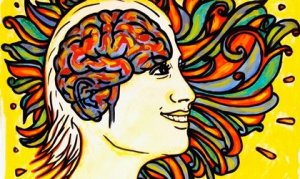Happiness is Located in Your Left Brain Hemisphere


Written and verified by the psychologist Valeria Sabater
Contrary to popular belief, our feelings and emotions don’t reside in our heart but in our brain. Recent studies show that a great part of our happiness is located in our left brain hemisphere. Each time we’re feeling excited, full of energy, positive, and hopeful, the area that presents the most neural activity is our left prefrontal cortex.
This is very interesting. Daniel Goleman talked about this in a New York Times article where he explained that disciplines such as psychology, Buddhism, and spirituality are working together in order to find answers to many questions about human beings.
In May 2000, there was a gratifying and productive meeting. Dalai Lama met with the best psychologists and neurologists at the time with one purpose in mind. It was a difficult yet practical purpose: to know how Buddhism handled negative emotions. They also wanted to find out what went on in a person’s brain when they meditated and focused on kindness, altruism, and happiness.
They met for five days in Dharamshala, India. This was a very productive meeting for one of the scientists, Dr. Richard Davidson. He’s the head of the Affective Neuroscience Laboratory at the University of Wisconsin and author of The Emotional Life of Your Brain. He left this meeting with a hypothesis:
“Recent research has shown that when we empathize, the brain activates many of the same networks that activate when we experience pain, physical or otherwise.”
-Dr. Richard Davidson-

Happiness is in your left brain hemisphere
Dr. Davidson is known for his research on affective neuroscience. He repeats one phrase in every single one of his conferences: the key to having a healthy life is having a healthy mind. Nowadays, he chairs the Center for Healthy Minds at the same university.
In the year 2008, he focused one of his studies on demonstrating the relationship between neuroplasticity and meditation techniques. He wanted to see if the people who had been practicing meditation techniques for a good part of their lives had a greater electric activity and improved concentration.
“Meditation gives you the wherewithal to pause, observe how easily the mind can exaggerate the severity of a setback, and resist getting drawn into the abyss.”
-Dr. Richard Davidson-
On the other hand, we can find his most interesting theories in his book The Emotional Life of Your Brain that was published in 2012. In it, he exposes that happiness is pretty much located in the left brain hemisphere. Let’s delve deeper into this idea.
Frontal lobes and our emotions
There have been many studies on the billion-neuron mass located inside our skull. Saying that happiness is located in our left brain hemisphere is a way of expressing how our positive emotions have also been developing through time.
- For example, up until recently, people assumed that emotions and feelings were located in the most primitive area of the brain, also known as the reptilian brain. This is the place where we can find the oldest structures such as the limbic system. This is the one in charge of regulating all emotional processes.
- However, neuroscience made another discovery more than 30 years ago. We already know that emotions aren’t exclusively located in that deep area of the brain we call the “limbic system”. In fact, this structure is directly connected to the frontal lobes, the structures involved in more complex thought processes.

Anguish, stress, and anxiety are located in the right brain hemisphere
Dr. Richard Davidson already had this in mind. He already knew about the existing relationship between the limbic system and the frontal lobes. However, after many years of research and some MRI testing, something drew his attention:
- The functional images revealed that when we feel anguished, stressed, or depressed, the most active areas of the brain are the circuits that converge in the amygdala, as well as in the right prefrontal cortex.
- The right prefrontal cortex is related to hypervigilance, something we experience when we’re feeling highly stressed.
The left brain hemisphere and positive emotions
Happiness lies in the left brain hemisphere or, more specifically, in the left frontal lobe. When we’re feeling calm, optimistic, relaxed, and hopeful, the right frontal lobe begins to show less activity due to the intense neuronal activity going on in the opposite one. This is a very important and striking fact that neuroscience validated.
“The amazing fact is that through mental activity alone we can intentionally change our own brains.”
-Dr. Richard Davidson-
If happiness is in the left brain hemisphere, how can we stimulate this area?
Dr. Davidson established that, in order to modify our brain activity, the best thing we can do is improve our thoughts and overall mental activity. This is something that the cognitive-behavioral approach backs up since this is greatly used for treating anxiety, depression, phobias, and stress.
Likewise, if happiness is located in the left brain hemisphere and you’d like to “appease” the hyperactivity of your right frontal lobe, we recommend you practice the following dimensions:
- Meditation.
- Kindness.
- Altruism.
- Give yourself some time to rest.
- Cultivate friendships.
- Keep a goal in mind (stay motivated).
- Be enthusiastic.
- Be positive and hopeful.

Regardless of where a certain process, quality, or competency is located, there’s one aspect we must always bear in mind. No one can modify and optimize our mental activity but us. We’re the ones who should want to live a happier, more flexible, and open life. We should give ourselves the opportunity to settle the authentic neurological foundations of happiness.
“As a result, nature has endowed the human brain with a malleability and flexibility that lets it adapt to the demands of the world it finds itself in. The brain is neither immutable nor static but continuously remodeled by the lives we lead.”
-Dr. Richard Davidson-
Contrary to popular belief, our feelings and emotions don’t reside in our heart but in our brain. Recent studies show that a great part of our happiness is located in our left brain hemisphere. Each time we’re feeling excited, full of energy, positive, and hopeful, the area that presents the most neural activity is our left prefrontal cortex.
This is very interesting. Daniel Goleman talked about this in a New York Times article where he explained that disciplines such as psychology, Buddhism, and spirituality are working together in order to find answers to many questions about human beings.
In May 2000, there was a gratifying and productive meeting. Dalai Lama met with the best psychologists and neurologists at the time with one purpose in mind. It was a difficult yet practical purpose: to know how Buddhism handled negative emotions. They also wanted to find out what went on in a person’s brain when they meditated and focused on kindness, altruism, and happiness.
They met for five days in Dharamshala, India. This was a very productive meeting for one of the scientists, Dr. Richard Davidson. He’s the head of the Affective Neuroscience Laboratory at the University of Wisconsin and author of The Emotional Life of Your Brain. He left this meeting with a hypothesis:
“Recent research has shown that when we empathize, the brain activates many of the same networks that activate when we experience pain, physical or otherwise.”
-Dr. Richard Davidson-

Happiness is in your left brain hemisphere
Dr. Davidson is known for his research on affective neuroscience. He repeats one phrase in every single one of his conferences: the key to having a healthy life is having a healthy mind. Nowadays, he chairs the Center for Healthy Minds at the same university.
In the year 2008, he focused one of his studies on demonstrating the relationship between neuroplasticity and meditation techniques. He wanted to see if the people who had been practicing meditation techniques for a good part of their lives had a greater electric activity and improved concentration.
“Meditation gives you the wherewithal to pause, observe how easily the mind can exaggerate the severity of a setback, and resist getting drawn into the abyss.”
-Dr. Richard Davidson-
On the other hand, we can find his most interesting theories in his book The Emotional Life of Your Brain that was published in 2012. In it, he exposes that happiness is pretty much located in the left brain hemisphere. Let’s delve deeper into this idea.
Frontal lobes and our emotions
There have been many studies on the billion-neuron mass located inside our skull. Saying that happiness is located in our left brain hemisphere is a way of expressing how our positive emotions have also been developing through time.
- For example, up until recently, people assumed that emotions and feelings were located in the most primitive area of the brain, also known as the reptilian brain. This is the place where we can find the oldest structures such as the limbic system. This is the one in charge of regulating all emotional processes.
- However, neuroscience made another discovery more than 30 years ago. We already know that emotions aren’t exclusively located in that deep area of the brain we call the “limbic system”. In fact, this structure is directly connected to the frontal lobes, the structures involved in more complex thought processes.

Anguish, stress, and anxiety are located in the right brain hemisphere
Dr. Richard Davidson already had this in mind. He already knew about the existing relationship between the limbic system and the frontal lobes. However, after many years of research and some MRI testing, something drew his attention:
- The functional images revealed that when we feel anguished, stressed, or depressed, the most active areas of the brain are the circuits that converge in the amygdala, as well as in the right prefrontal cortex.
- The right prefrontal cortex is related to hypervigilance, something we experience when we’re feeling highly stressed.
The left brain hemisphere and positive emotions
Happiness lies in the left brain hemisphere or, more specifically, in the left frontal lobe. When we’re feeling calm, optimistic, relaxed, and hopeful, the right frontal lobe begins to show less activity due to the intense neuronal activity going on in the opposite one. This is a very important and striking fact that neuroscience validated.
“The amazing fact is that through mental activity alone we can intentionally change our own brains.”
-Dr. Richard Davidson-
If happiness is in the left brain hemisphere, how can we stimulate this area?
Dr. Davidson established that, in order to modify our brain activity, the best thing we can do is improve our thoughts and overall mental activity. This is something that the cognitive-behavioral approach backs up since this is greatly used for treating anxiety, depression, phobias, and stress.
Likewise, if happiness is located in the left brain hemisphere and you’d like to “appease” the hyperactivity of your right frontal lobe, we recommend you practice the following dimensions:
- Meditation.
- Kindness.
- Altruism.
- Give yourself some time to rest.
- Cultivate friendships.
- Keep a goal in mind (stay motivated).
- Be enthusiastic.
- Be positive and hopeful.

Regardless of where a certain process, quality, or competency is located, there’s one aspect we must always bear in mind. No one can modify and optimize our mental activity but us. We’re the ones who should want to live a happier, more flexible, and open life. We should give ourselves the opportunity to settle the authentic neurological foundations of happiness.
“As a result, nature has endowed the human brain with a malleability and flexibility that lets it adapt to the demands of the world it finds itself in. The brain is neither immutable nor static but continuously remodeled by the lives we lead.”
-Dr. Richard Davidson-
This text is provided for informational purposes only and does not replace consultation with a professional. If in doubt, consult your specialist.







